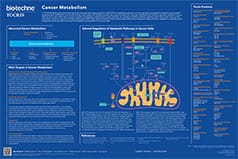p97 ATPase
p97, also known as valosin-containing protein (VCP) in mammals or Cdc48 in yeast, is an ATPase that promotes protein degradation by acting as a protein segregase to remove proteins from membranous structures, chromatin or complexes using the energy generated by ATP hydrolysis.
p97 ATPase Inhibitors |
|
|---|---|
| Cat. No. | Product Name / Activity |
| 7379 | CB 5083 |
| Potent p97 ATPase inhibitor | |
| 5153 | ML 240 |
| ATP-competitive inhibitor of p97 ATPase | |
| 6180 | NMS 873 |
| Potent and selective p97 ATPase (VCP) allosteric inhibitor | |
| 4686 | Xanthohumol |
| p97 ATPase (VCP) inhibitor | |
p97, also known as valosin-containing protein (VCP) in mammals or Cdc48 in yeast, is an ATPase that promotes protein degradation by acting as a protein segregase. It does this by removing proteins from membranous structures, chromatin or protein complexes using the energy generated by ATP hydrolysis.
Ubiquitously expressed in mammals, p97 is primarily localized to the cytoplasm but is also found in the nucleus and associated with the membranes of subcellular organelles. Its main role is to maintain protein homeostasis via its involvement in ER-associated protein degradation (ERAD) in addition to degradation processes associated with mitochondria, chromatin and ribosomes.
p97 is a member of the Type II AAA+ ATPase family. These enzymes consist of a large N-terminal domain that interacts with proteins, followed by two ATPase domains, D1 and D2. The active protein exists as a homohexamer which adopts a double ring-like structure around a central pore.
Many missense mutations in p97 have been linked to the development of inclusion body myopathy associated with Paget's disease of the bone and frontotemporal dementia (IBMPFD). These mutations all localize to domain interfaces, but do not affect the structure or ATPase activity of p97, suggesting communication between domains is vital for protein function.
In addition, inhibitors of p97 have previously been shown to exhibit anticancer properties making p97 a target for cancer research and p97 mutations are thought to contribute towards the development of the neurodegenerative condition, amyotrophic lateral sclerosis (ALS).
External sources of pharmacological information for p97 ATPase :
Literature for p97 ATPase
Tocris offers the following scientific literature for p97 ATPase to showcase our products. We invite you to request* your copy today!
*Please note that Tocris will only send literature to established scientific business / institute addresses.
Cancer Metabolism Poster
This poster summarizes the main metabolic pathways in cancer cells and highlights potential targets for cancer therapeutics. Genetic changes and epigenetic modifications in cancer cells alter the regulation of cellular metabolic pathways providing potential cancer therapeutic targets.
